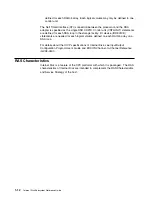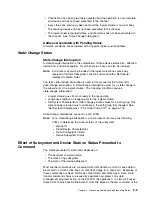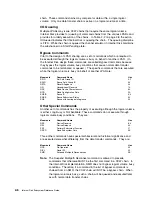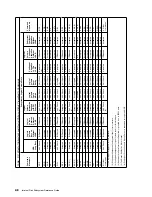
Track Accessing
To access a specific track, the host program must first specify the desired cylinder
and track. This positioning occurs without requiring the device to read any user
data. When the track accessing operation completes, the track address (CCHH) is
saved and maintained by the subsystem until changed by subsequent host
commands.
Each command chain must include a command that specifies or implies a (CCHH)
before a Seek Head command or any command requiring track data access.
Commands that specify or imply a (CCHH) are Seek, Seek Cylinder, Locate
Record, Locate Record Extended, and Read IPL.
A Locate Record command, Read IPL command, any seek command, or track
switching in a multitrack operation can access a track. See “Multitrack Operations”
on page 4-2.
Positioning within a track allows a search command to start just before a record
instead of searching from the beginning of a cache track image. This positioning
can be done because a division of the track has evenly spaced
sectors
. The
Locate Record, Locate Record Extended, or the Set Sector commands do sector
positioning.
Track Orientation
To access data on the track, the control unit first establishes orientation, which is a
state of awareness of the type of area that has just been processed. If the control
unit does not know this, the control unit is
not oriented
.
Orientation occurs by finding either the start of the track (index), or the start of a
count area other than the record zero count area. As the channel program
continues, the control unit maintains orientation, switching from one orientation
state to another as it proceeds through successive areas and records.
The control unit is in the reset orientation state at the start of a channel program. A
command that requires read or write data causes the control unit to orient to either:
Index state, by locating the index point
Precount state, by locating a count area (other than R0).
For operations that read or write data, the control unit maintains orientation,
changing states as it reads, writes, searches or skips areas. Commands other than
those grouped under the Read Commands, Write Commands and Search
Commands headings in this specification do not process track data and therefore,
cause track orientation to be reset. When a channel program ends, track
orientation is reset.
Note:
Throughout this document, the phrase “oriented to...” is used
interchangeably with the phrase “in the ... orientation state.” For example,
“oriented to a data area” has the same meaning as “in the data area
orientation state.”
3-2
Internal Disk Subsystem Reference Guide
Содержание Multiprise 3000
Страница 1: ...S 390 Multiprise 3000 Enterprise Server R IBM Internal Disk Subsystem Reference Guide SA22 1025 00 ...
Страница 2: ......
Страница 3: ...S 390 IBM Internal Disk Subsystem Reference Guide SA22 1025 00 ...
Страница 32: ...2 12 Internal Disk Subsystem Reference Guide ...
Страница 38: ...3 6 Internal Disk Subsystem Reference Guide ...
Страница 182: ...4 144 Internal Disk Subsystem Reference Guide ...
Страница 198: ...5 16 Internal Disk Subsystem Reference Guide ...
Страница 214: ...6 16 Internal Disk Subsystem Reference Guide ...
Страница 234: ...A 10 Internal Disk Subsystem Reference Guide ...
Страница 238: ...B 4 Internal Disk Subsystem Reference Guide ...
Страница 243: ...4 lease the Code or any copy of it Appendix C Warranties C 5 ...
Страница 244: ...C 6 Internal Disk Subsystem Reference Guide ...
Страница 248: ...D 4 Internal Disk Subsystem Reference Guide ...
Страница 254: ...X 6 Internal Disk Subsystem Reference Guide ...
Страница 263: ......
Страница 264: ...IBM Printed in the United States of America on recycled paper containing 10 recovered post consumer fiber SA22 1 25 ...






























